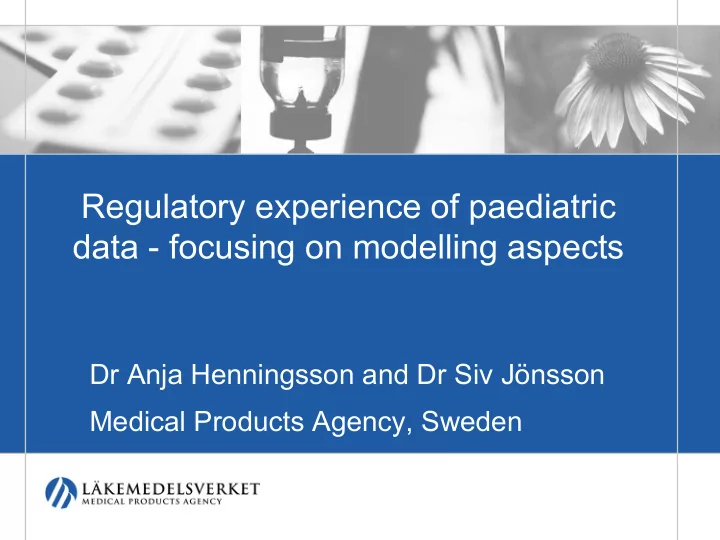

Regulatory experience of paediatric data - focusing on modelling aspects Dr Anja Henningsson and Dr Siv Jönsson Medical Products Agency, Sweden
Outline • Experience of paediatric data • Methodological aspects � Aspects to consider when adult data available � Developmental effects on PK (growth, maturation) • Regulatory assessment of PK and PKPD analyses
PK and PKPD modelling in submitted paediatric files • PKPD analyses paediatric data rare � if at all included - simple exposure response relations No mechanistic PKPD models applied to paediatric data so far • Population PK models often included � data often very sparse � models for influence of growth and maturation on PK vary � varying quality of analyses and reports
Aspects to consider if adult data available Disease model Clinical Present/Estimated? endpoint Valid? Disease dependent? PKPD PK Efficacy Biomarkers Dose Safety Developmental dependent Developmental dependent? or Similar? Allometric scaling? CPMP/ICH/2711/99. ICH Topic E 11 Clinical Investigation of Medicinal Products in the Paediatric Population Physiology- based CHMP/EWP/147013/04 Role of Pharmacokinetics in the Development of Medicinal Products in the Paediatric simulations? Population
Tolterodin EU Worksharing in Paediatric Assessment • Over active bladder syndrome (Adults) • Assumption: similar exposure - effective in urinary urge incontinence suggestive of detrusor instability • PK characterised in children 1 month – 15 years � traditional PK studies and population PK analyses • Weight-based dose in children 5-10 years � 2 mg qd < 35 kg and 4 mg qd > 35 kg => similar exposure as in adults
Tolterodin EU Worksharing in Paediatric Assessment • Two studies in children 5-10 years � 2 mg qd used in all children � no convincing results in primary endpoint (frequency of incontinence) � no clinically meaningful effect Why? – different disease? different PKPD expected? too low dose? Recommendation: Clinical condition should be carefully described and well defined e.g. neurologic bladder disorder, urogenital malformations or other and studied separately
Aspects on modelling of growth and maturation effects on PK Size: BW, FFM, BMI, BSA, HT etc - Allometric scaling, fixed or estimated coefficients? - A priori inclusion or tested for significance? Age classification in current guidelines: Puberty onset? Organ maturation: postmenstrual, gestational, postconceptual or Preterm or Term Infants and Children Adolescents postnatal age? newborn infants toddlers Modelling approach: Empirical PBPK 0-27 days 28 days- 2-11 years 12-17 years 23months AGE Meibohm et al AAPS J 2005, Population pharmacokinetic studies in pediatrics: issues in design …. Anderson & Holford Ann. Rev. Pharamcol. Toxicol. 2008 Mechanism-based concepts of size and maturity..
Example 1 Model parameterisation • Parameterised as V1and k e • V1 dependent on size as: TVV1=X+Y(BSA-Median) • k e included no covariate relation More easily interpretable if size effects are modelled on Clearance and Volume
Example 2 Multiple covariates • Pop PK model based on adult and paediatric data • Covariate relation modelled as additive covariate effects • Subjects with low body size - simulations: Without co-administered drug With co-administered drug Likely or model induced?
Example 2 Multiple covariates • "Additive" model (left graph) CL= θ 1+ θ 2*(BSA - 1.77) + θ 3*CAT+ θ 4*C INH /( θ 5+ C INH )…… • "Proportional" model (right graph) CL= ( θ 1+ θ 2*(BSA - 1.77))*(1+ θ 3*CAT+ θ 4*C INH /( θ 5+ C INH )………
Example 3 Influence of size and age BW Θ BW =0.75 for CL and =1 for V Θ t1/2 = half life of maturation
Regulatory assessment of PK and PKPD Modelling and Simulation • Model development ??? methodology in general • Model adequate for it's intended use? Assessment and demands vary within EU – composes 30 EU and EFTA countries – Swedish view presented here
Regulatory assessment of M &S • What is acceptable? � evolving science � no European guideline defining what is acceptable Guideline on reporting the results of population pharmacokinetic analyses (CHMP/EWP/185990/06) � requirements on a case by case basis • intended use • relative importance � demands on model evaluation ↑ with ↑ importance
Regulatory assessment of M &S • Model evaluation issues � paediatric data + (rich) adult data predictive for the paediatric population? • use stratified model evaluation � sparse data - shrinkage towards the mean • Empirical Bayes estimate based diagnostics may be of limited value (perfect fit!) • Graphs of Empirical Bayes estimates versus e.g. weight or age - trends may be highly dependent on the model
Regulatory Assessment of M & S • Limited resources • Requires hands on experience • Continuous education needed • Current situation: � Not all submitted population analyses are assessed in detail (depends on relative importance) � No questions on the models ≠ full acceptance of the model for later use � The more valuable the model the more questions asked
Conclusions • PKPD modelling rare (simple relations if any) • PK-Efficacy � extrapolate efficacy from the adult population • PK-Safety � adequate exposure entire age span? � identify risk groups • Population PK analyses of varying quality � Divergent handling of size and maturation effects
Conclusions • Model-based drug development highly appreciated – Avoid unnecessary studies! • Reports should be sufficiently detailed - Show that the model is predictive!
Recommend
More recommend